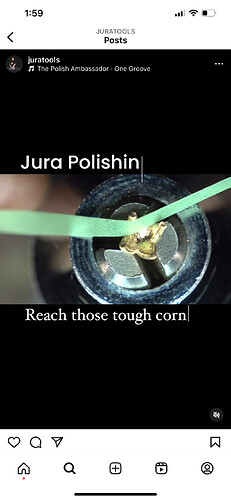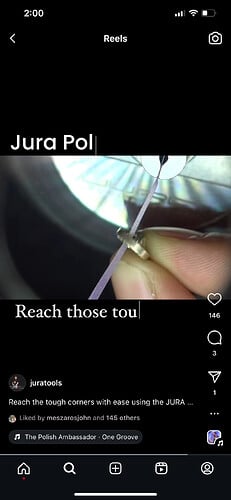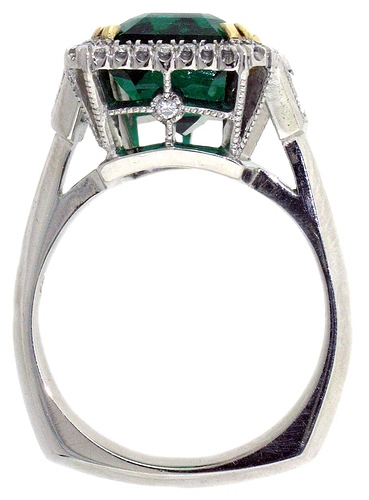i’ve been struggling to find the correct shaped bits to finish the metal inside the seat of my casted piece (as well as any tiny hard to reach areas!) i have been using mostly radial discs and sandpaper wheels to pre-polish my castings and pumice wheels once stones are set. the radial discs don’t reach into the hole and the pointed shape pumice bits don’t seem to do as much as the wheels, even the coarsest point (i have the blue, yellow and grey EVE pumice wheels) doesn’t remove the pale rough surface of a freshly cast piece. I’ve gone into the area with a round burr before to get a shine before I set my stone but am afraid of removing material and changing the shape of my seat!
I don’t set faceted stones, but have some thoughts. If you don’t already, you might consider learning the basics of hand engraving to remove small bits of metal in tight places. You can also find all kinds of small and large bits that you can use with your flex tool or micro motor. Finally, although I am sure others have more ideas, look at ceramic stones and polishing sticks (think large tooth picks). These are used by die makers to get into very tight places to first remove metal and then polish the surface. Gesswein sells a lot of them and their customer service people are very helpful. Good luck…Rob
The best way to polish the interior of settings and other small interstices is to thrum them.
Thrumming is the process of threading string charged with polishing compound through the holes and moving the piece up and down along the thread to polish the interior. It is a practice that is followed only in the finest shops, much as mise-à-jour is only done in the best ateliers these days.
It is also possible to purchase abrasive cords in various grits, but those cut much faster than string charged with cutting compound, thus it is too easy to cut unwanted grooves into the interior.
Here is an interview with a polisher at Van Cleef & Arpels explaining and demonstrating the process of thrumming. It’s in French with subtitles. This entire series, Les Mains d’Or, is worth watching.
Hi,
a coupla thoughts…
i am not sure what size your stone seats are…and i am not sure the cast seat is already a perfect fit, or if metal removal is neccessary to fit the stone…
you can try:
(high shine)
- burnishing the seats…either with a hand burnisher, or a burnishing bit…this will not remove metal, only compress it
hand burnishers:
burnishing bits:
(refining surface prior to high polish)
2) stone or ceramic points:
i like stone burs…they are in between metal burs and silicone wheels…more like sand paper…
there used to be more brands/ colors/ grits available, but searching rio grande has become sure a chore…i couldnt find the red ruby points…
these white arkansas stones are 330 grit:
i have never seen these ceremic points before…i may need to try them…i do have ceramic stick/ strips with holders…but i havent figured out how to best use them…they probably work best in a reciprocating polisher…
- silicone cylinders/ points/ wheels:
you can “dress” / shape the wheels to fit into the space you are working on…
-
escapement files…cut 2,4,6,8
my favorite files when working small…you can gentlt smooth out the surfaces before moving to stone or silicone… -
felt points/ cylinders/ wheels, with compounds
(or toothpicks…q-tips…cotton on a stick…
julie
Hi,
one of the reviews for the above dedeco ceramic points, says that they are softer than hard stone points…
i just found a large assortment of silicone carbide and aluminum oxide stone points, on foredom.net site (page 1 and 3)
https://www.foredom.net/product-category/burs-bits-cutters-buffs/abrasive-points-stones-discs/
this is good to know, where i can get more!
julie
This video shows how really good finishing is very much done by hand. We all look for shortcuts and sometimes we find them. I have a number of them, some of which work, some that don’t. My standard for a good finish was set long ago and if I can’t achieve it with a machine or some other shortcut, I go back to working with various grit wheels, files, buffs, compounds, strips of abrasive paper, soft and hard wood strips, tooth picks and thrum strings because I don’t want to compromise my standards. The thing that I haven’t been able to figure out is how to use a small round bristle brush either on my lathe or flex shaft to polish metal with tripoli and rouge. Are there other compounds that work better with these brushes?..Rob
I use a toothpick charged with compound in hard to reach areas, or I will use a shaped wire brush. I take a cone type brush and twist the bristles into a point that I can bend and maneuver into tight areas to burnish them. It won’t be as high a polish as thrumming but it gets rid of the dull matte color that appears after casting or pickling.
Hi,
ah yes, i always forget about the benefits of wire brushes!
julie
You can use various burs to get at flashing and pits inside a setting and still not remove too much metal if you use a pin vise rather than a flex shaft.
A much more costly alternative would be a low torque micromotor run at a very low speed so the bit stops rotating if you are being too heavy with it and having it cut too much. In case you want an excuse to buy a micromotor. ![]()
Neil A
Neil…I do want a micromotor, I just don’t need it. That doesn’t mean that I won’t have one soon. You mention pin vise’s. I have several and recently discovered that I have a lot more control over wire form solder if I hold it in a pin vise to do touch soldering. Remember that my hands are damaged and 75 years old. I bought a set of three inexpensive pin vise’s and leave them loaded with easy, medium and hard solder wire, one in each pin vise. I use a simple sharpie mark on the pin vise cylinder to keep track of what type of solder is in each one. I use a more heavy duty pin vise for slow drilling and clean up with different burrs. Hope all is well…Rob
There’s the spirit! ![]()
When I was taking community ed jewelry classes regularly I bought the Foredom Portable Micromotor
so I could do stone setting and not tie up the class flex shafts (and not have to leave my bench). I actually like that it is low torque as I do not have a highly skilled hand with the much stronger flex shaft. It is too easy for me to cut too much with a flex shaft, much less so with this micromotor.
Pin vises are very handy tools.
Hope all is well
I survived the 112-114* days (how do Arizonans stand that?) and have moved onto gutting / rebuilding another room of the house, so yes, things are good here. I hope they are as well with you & all on Orchid.
Neil A
And if you have a micro motor, after using your bur, reverse rotation and you can kinda polish the cut…
Judy H
Thrumming might be my favorite word in jewelry making! I love the way it sounds.
I have to get back to you all because I’ve got the info at work, A local jeweler turned me onto something that’s used in the dental industry. It’s very fine sanding film that’s mounted on thin plastic film. It’s about 5-7mm wide. You can use it full width or it can be cut into as thin as 1 mm strips. It’s designed to sand crowns after they’ve been installed in between teeth. Kind of gross to think about, but for jewelry finishing they’re awesome. You use this sanding film just like thrumming with string and buffing compound. It’s only available at Dental Supply stores.
My favorite way to polish inside seats is to use bristle end brushes vs bristle side brushes. People mentioned a number of suggestions, but I don’t think anyone said bristle end brushes.
Jeff
thank you jeff!!! these brushes will work to get off the initial dull casting surface?
Hi Jeff,
my dentist gave me some of those strips!
i recently saw an instagram post from juratools…they are now selling jura polishing strips!
julie
The answer is probably. I can’t tell for sure without seeing the setting that you’re talking about.
With bristle brushes you adjust the coarseness by adjusting the coarseness of your buffing compound.
If you have a complicated shape to polish and clean up, you might need to use a variety of the techniques that folks have suggested. But these end brushes will either do what you need completely or at least help a lot.
can’t wait to try them out!!
Just to mention, one common issue with bristle brushes (both side and end brushes) is buffing compound caking up on the area that you’re polishing. Remember that buffing compound is an abrasive powder with a binder that melts with the heat of the spinning buff. Bristle brushes tend to be cooler than cotton buffs when spinning, which can lead to the buffing compound caking and creating a barrier to actually buffing. You have to outwit this somehow. That can mean buffing at faster or slower speeds, more or less pressure, more or less compound. You might need to clean off the excess buffing compound with soap and water during the polishing process a few times. There are also firm and soft bristle brushes. You’ll probably need both.
I’ve found buffing compounds with an oil based binder works better with bristle brushes than water based binders. (but both types will work, use what you have)
The main thing is that bristle brushes work similarly to cotton buffs, but aren’t exactly the same.
Have fun and good luck!!
Jeff
I had the great opportunity during my apprenticeship to learn finishing from a german trained polisher.
Helga taught me the skill of thrumming. I also learned that abrasion is not the only way to get a good finish. sometimes it’s easier to move metal that to remove it. I’ve attached photos of both the tools and the results of thrumming as well as burnisihing. I have a multitude of burnishers. some store bought some home made. For the inside of the seat area of the crown I use a small home made
burnisher. For the prongs and under gallery I would thrum. Also for thrumming I use cotton cord with different compounds on individual strands and also fine abrasive tape. To make it easier to threat the cords into tiny places I add super glue to the tip of the cord and after the glue is set file it to a point.
fantastic information, thank you thank you thank you! i think burnishers of different sizes might be what i am missing in my arsenal.







